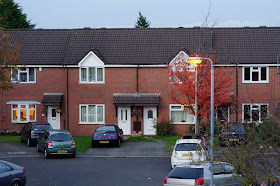Notes on life, art, photography and technology, by a Danish dropout bohemian.
▼
Saturday, October 30, 2010
Glowing leaves (updated)
Pentax K-r, 70mm F:2.4 (at 2.4 and F:13), 1600 ISO, Photoshop fx.
Not much light, so some (like the top one) I shot at 1/30 second. With a 100mm-equivalent lens, I was sure I couldn't hold that still, so I used the trick of setting the camera on continous firing, and fired off 3-4 shots of each. This will, amazingly enough, usually give one shot which is sharp.
But the in-body Shake Reduction of the Pentax must be better than I thought, because all the shots were sharp!* Very interesting. I guess it means if I use both methods, perhaps I can get sharp shots at 1/8 second with that short tele. ... Hey, why not test it?
No sooner thought than done:
It's decidedly dusk outside, much darker than it looks in this picture. (Yep, ten minutes later it's night.) It's F:6.4 at 1/8 second, and pin-sharp! Kewl. I took four shots in a burst, the first two were blurred, the last two were sharp.
Below is a 100% view (if you click for full size), first fresh from the camera, then with application of sharpen and de-noising filters. Remarkable.
Update:
By the way, "sharpening" in the computer does not create more detail in the photo. What is does is simply enhance the contrast at the edges, which gives the appearance of sharpness!
That type of sharpness is called acutance. An old Agfa film developer called Rodinal created the most amazing acutance, photos seemed so wonderfully sharp. But it had the same downside as Sharpening in software has: it also sharpens noise ("grain" on film), so the noise become more prominent. So it's a whole science to use this (and anti-noise filters) to the best effect.
*I dunno how "sharp" the leaf-pictures seem to you, cuz I did not process towards that in this case, I did not apply any sharpening in Photoshop, which is otherwise pretty standard, and furthermore I used a filter to get that "soft-focus"-like glow the pictures have. Just for fun, now we're talking about it, here's a more standard processing:






Autumn leaves everywhere ! :)
ReplyDeleteThanks for sharing.
Actually I have some technical questions:
- what is the name of this softening filter in photoshop? I never thought of using filters, but this makes me feel like trying. :)
- about sharpening, does it work? I am sometimes trying, ok, not on Photoshop but on iPhoto, that is a very quick handy and nice program that comes with Mac, and I tried sharpening and I never really saw a result... Could you post something about sharpening, "before" and "after"?
Ok, I have just seen the other pics, that is exactly what I asked. :)
ReplyDeleteWell, ok, it is nice, but does not turn the blurred image into a crisp image... So there is no other solution, one has to take sharp images... :)
That's right. You can recover detail which is not there.
ReplyDeleteThe filter is Glamour Glow, included in a Nik's Software collection, I think it's Color Efex Pro Complete, which is good, but unfortunately pretty expensive (I think like 150 Euro or so). I had an intense discussion with Nik this summer, I was so pissed off that I had to pay for the whole collection when I only needed one or two filters.
(Also, Glamour Glow needs to be done lightly. And it's a good idea to lighten shadows first, since it darkens them quite a bit.)
By the way, "sharpening" in the computer does not create more detail in the photo. What is does is simply enhance the contrast at the edges, which gives the appearance of sharpness!
ReplyDeletePost updated with this:
ReplyDeleteThat type of sharpness is called acutance. An old Agfa film developer called Rodinal created the most amazing acutance, photos seemed so wonderfully sharp. But it had the same downside as Sharpening in software has: it also sharpens noise ("grain" on film), so the noise become more prominent. So it's a whole science to use this (and anti-noise filters) to the best effect.
acutance... learned something, thanks ! :)
ReplyDelete